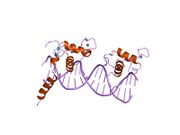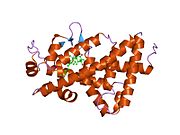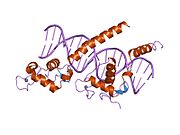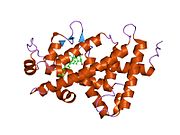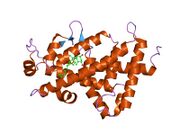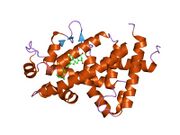Biology:Calcitriol receptor
 Generic protein structure example |
The calcitriol receptor, more commonly known as the vitamin D receptor (VDR) and also known as NR1I1 (nuclear receptor subfamily 1, group I, member 1), is a member of the nuclear receptor family of transcription factors.[1] Calcitriol, the active form of vitamin D, binds to the VDR, which then forms a heterodimer with the retinoid-X receptor. This then binds to hormone response elements on DNA resulting in expression or transrepression of specific gene products. The VDR not only regulates transcriptional responses but also involved in microRNA-directed post transcriptional mechanisms.[2] In humans, the vitamin D receptor is encoded by the VDR gene.[3]
Glucocorticoids are known to decrease expression of VDR, which is expressed in most tissues of the body and regulate intestinal transport of calcium, iron and other minerals.[4]
Function
The VDR gene encodes the nuclear hormone receptor for vitamin D3. This receptor also functions as a receptor for the secondary bile acid lithocholic acid. The receptor belongs to the family of trans-acting transcriptional regulatory factors and shows similarity of sequence to the steroid and thyroid hormone receptors.[5]
Downstream targets of this nuclear hormone receptor are involved principally in mineral metabolism though the receptor regulates a variety of other metabolic pathways, such as those involved in the immune response and cancer.[6]
Mutations in this gene are associated with type II vitamin D-resistant rickets. A single nucleotide polymorphism in the initiation codon results in an alternate translation start site three codons downstream. Alternative splicing results in multiple transcript variants encoding the same protein.[7] VDR gene variants seem to influence many biological endpoints, including those related to osteoporosis [8]
The vitamin D receptor plays an important role in regulating the hair cycle. Loss of VDR is associated with hair loss in experimental animals.[9] Experimental studies have shown that the unliganded VDR interacts with regulatory regions in cWnt (wnt signaling pathway) and sonic hedgehog target genes and is required for the induction of these pathways during the postnatal hair cycle.[10] These studies have revealed novel actions of the unliganded VDR in regulating the post-morphogenic hair cycle.
Interactions
Calcitriol receptor has been shown to interact with
- BAG1,[11]
- BAZ1B,[12]
- CAV3,[13]
- MED1,[12][14]
- MED12,[12][14]
- MED24,[12][14]
- NCOR1,[15]
- NCOR2,[15][16]
- NCOA2,[12][17][18][19]
- RXRA,[18][20]
- RUNX1,[16]
- RUNX1T1,[16]
- SNW1,[18][20]
- STAT1,[21] and
- ZBTB16.[16][22]
Interactive pathway map
References
- ↑ "International Union of Pharmacology. LXII. The NR1H and NR1I receptors: constitutive androstane receptor, pregnene X receptor, farnesoid X receptor alpha, farnesoid X receptor beta, liver X receptor alpha, liver X receptor beta, and vitamin D receptor". Pharmacol. Rev. 58 (4): 742–59. December 2006. doi:10.1124/pr.58.4.6. PMID 17132852. https://semanticscholar.org/paper/804cbdbb65af306863e0ac76a65813e3030ff820.
- ↑ "Vitamin D activation of functionally distinct regulatory miRNAs in primary human osteoblasts". J Bone Miner Res 28 (6): 1478–14788. June 2013. doi:10.1002/jbmr.1882. PMID 23362149.
- ↑ "The Sp1 transcription factor gene (SP1) and the 1,25-dihydroxyvitamin D3 receptor gene (VDR) are colocalized on human chromosome arm 12q and rat chromosome 7". Genomics 11 (1): 168–73. September 1991. doi:10.1016/0888-7543(91)90114-T. PMID 1662663.
- ↑ "Molecular Mechanisms for Regulation of Intestinal Calcium Absorption by Vitamin D and Other Factors". Crit Rev Clin Lab Sci 47 (4): 181–195. August 2010. doi:10.3109/10408363.2010.536429. PMID 21182397.
- ↑ "Overview of nomenclature of nuclear receptors". Pharmacol. Rev. 58 (4): 685–704. December 2006. doi:10.1124/pr.58.4.2. PMID 17132848.
- ↑ "Vitamin D receptor agonists, cancer and the immune system: an intricate relationship". Curr Top Med Chem 6 (12): 1297–301. 2006. doi:10.2174/156802606777864890. PMID 16848743.
- ↑ "Entrez Gene: VDR vitamin D (1,25- dihydroxyvitamin D3) receptor". https://www.ncbi.nlm.nih.gov/sites/entrez?Db=gene&Cmd=ShowDetailView&TermToSearch=7421.
- ↑ "Genetic Determinants of Vitamin D-Related Disorders; Focus on Vitamin D Receptor". Current Drug Metabolism 19 (12): 1042–1052. 2018-10-19. doi:10.2174/1389200219666180723143552. PMID 30039758.
- ↑ "The vitamin D receptor, the skin and stem cells". J. Steroid Biochem. Mol. Biol. 121 (1–2): 314–6. July 2010. doi:10.1016/j.jsbmb.2010.01.015. PMID 20138991.
- ↑ "The Vitamin D Receptor Is Required for Activation of cWnt and Hedgehog Signaling in Keratinocytes". Mol. Endocrinol. 28 (10): 1698–1706. September 2014. doi:10.1210/me.2014-1043. PMID 25180455.
- ↑ "BAG1L enhances trans-activation function of the vitamin D receptor". J. Biol. Chem. 275 (52): 40749–56. December 2000. doi:10.1074/jbc.M004977200. PMID 10967105.
- ↑ 12.0 12.1 12.2 12.3 12.4 "The chromatin-remodeling complex WINAC targets a nuclear receptor to promoters and is impaired in Williams syndrome". Cell 113 (7): 905–17. June 2003. doi:10.1016/S0092-8674(03)00436-7. PMID 12837248.
- ↑ "Membrane Localization, Caveolin-3 Association and Rapid Actions of Vitamin D Receptor in Cardiac Myocytes". Steroids 75 (8–9): 555–9. 2010. doi:10.1016/j.steroids.2009.12.001. PMID 20015453.
- ↑ 14.0 14.1 14.2 "Identity between TRAP and SMCC complexes indicates novel pathways for the function of nuclear receptors and diverse mammalian activators". Mol. Cell 3 (3): 361–70. March 1999. doi:10.1016/S1097-2765(00)80463-3. PMID 10198638.
- ↑ 15.0 15.1 "The interaction of the vitamin D receptor with nuclear receptor corepressors and coactivators". Biochem. Biophys. Res. Commun. 253 (2): 358–63. December 1998. doi:10.1006/bbrc.1998.9799. PMID 9878542.
- ↑ 16.0 16.1 16.2 16.3 "AML-associated translocation products block vitamin D(3)-induced differentiation by sequestering the vitamin D(3) receptor". Cancer Res. 62 (23): 7050–8. December 2002. PMID 12460926.
- ↑ "Antagonistic action of a 25-carboxylic ester analogue of 1alpha, 25-dihydroxyvitamin D3 is mediated by a lack of ligand-induced vitamin D receptor interaction with coactivators". J. Biol. Chem. 275 (22): 16506–12. June 2000. doi:10.1074/jbc.M910000199. PMID 10748178.
- ↑ 18.0 18.1 18.2 "Ternary complexes and cooperative interplay between NCoA-62/Ski-interacting protein and steroid receptor coactivators in vitamin D receptor-mediated transcription". J. Biol. Chem. 276 (44): 40614–20. November 2001. doi:10.1074/jbc.M106263200. PMID 11514567.
- ↑ "Electrostatic Modulation in Steroid Receptor Recruitment of LXXLL and FXXLF Motifs". Mol. Cell. Biol. 23 (6): 2135–50. March 2003. doi:10.1128/MCB.23.6.2135-2150.2003. PMID 12612084.
- ↑ 20.0 20.1 "Isolation and characterization of a novel coactivator protein, NCoA-62, involved in vitamin D-mediated transcription". J. Biol. Chem. 273 (26): 16434–41. June 1998. doi:10.1074/jbc.273.26.16434. PMID 9632709.
- ↑ "Stat1-Vitamin D Receptor Interactions Antagonize 1,25-Dihydroxyvitamin D Transcriptional Activity and Enhance Stat1-Mediated Transcription". Mol. Cell. Biol. 22 (8): 2777–87. April 2002. doi:10.1128/MCB.22.8.2777-2787.2002. PMID 11909970.
- ↑ "The acute promyelocytic leukemia-associated protein, promyelocytic leukemia zinc finger, regulates 1,25-dihydroxyvitamin D(3)-induced monocytic differentiation of U937 cells through a physical interaction with vitamin D(3) receptor". Blood 98 (12): 3290–300. December 2001. doi:10.1182/blood.V98.12.3290. PMID 11719366.
Further reading
- "[Polymorphisms of vitamin D receptor gene]". Nippon Rinsho 60 Suppl 3: 106–10. 2002. PMID 11979895.
- "Genetics and biology of vitamin D receptor polymorphisms". Gene 338 (2): 143–56. 2004. doi:10.1016/j.gene.2004.05.014. PMID 15315818. http://repub.eur.nl/pub/73442.
- "Minireview: vitamin D receptor: new assignments for an already busy receptor". Endocrinology 147 (12): 5542–8. 2007. doi:10.1210/en.2006-0946. PMID 16946007.
- "Differentiation of human keratinocytes requires the vitamin d receptor and its coactivators". J. Invest. Dermatol. 127 (4): 748–50. 2007. doi:10.1038/sj.jid.5700692. PMID 17363957.
- "RXR alpha, a promiscuous partner of retinoic acid and thyroid hormone receptors". EMBO J. 11 (4): 1409–18. 1992. doi:10.1002/j.1460-2075.1992.tb05186.x. PMID 1314167.
- "A single receptor identical with that from intestine/T47D cells mediates the action of 1,25-dihydroxyvitamin D-3 in HL-60 cells". Biochim. Biophys. Acta 1132 (1): 103–8. 1992. doi:10.1016/0167-4781(92)90063-6. PMID 1324736.
- "A unique mutation in the vitamin D receptor gene in three Japanese patients with vitamin D-dependent rickets type II: utility of single-strand conformation polymorphism analysis for heterozygous carrier detection". Am. J. Hum. Genet. 49 (3): 668–73. 1991. PMID 1652893.
- "The Sp1 transcription factor gene (SP1) and the 1,25-dihydroxyvitamin D3 receptor gene (VDR) are colocalized on human chromosome arm 12q and rat chromosome 7". Genomics 11 (1): 168–73. 1992. doi:10.1016/0888-7543(91)90114-T. PMID 1662663.
- "Vitamin D receptor expression in human lymphocytes. Signal requirements and characterization by western blots and DNA sequencing". J. Biol. Chem. 266 (12): 7588–95. 1991. PMID 1850412.
- "The molecular basis of hereditary 1,25-dihydroxyvitamin D3 resistant rickets in seven related families". J. Clin. Invest. 86 (6): 2071–9. 1991. doi:10.1172/JCI114944. PMID 2174914.
- "A unique point mutation in the human vitamin D receptor chromosomal gene confers hereditary resistance to 1,25-dihydroxyvitamin D3". Mol. Endocrinol. 4 (4): 623–31. 1991. doi:10.1210/mend-4-4-623. PMID 2177843.
- "Cloning and expression of full-length cDNA encoding human vitamin D receptor". Proc. Natl. Acad. Sci. U.S.A. 85 (10): 3294–8. 1988. doi:10.1073/pnas.85.10.3294. PMID 2835767.
- "Point mutations in the human vitamin D receptor gene associated with hypocalcemic rickets". Science 242 (4886): 1702–5. 1989. doi:10.1126/science.2849209. PMID 2849209.
- "Two mutations causing vitamin D resistant rickets: modelling on the basis of steroid hormone receptor DNA-binding domain crystal structures". Clin. Endocrinol. 41 (5): 581–90. 1995. doi:10.1111/j.1365-2265.1994.tb01822.x. PMID 7828346.
- "Hereditary 1 alpha,25-dihydroxyvitamin D-resistant rickets resulting from a mutation in the vitamin D receptor deoxyribonucleic acid-binding domain". J. Clin. Endocrinol. Metab. 78 (2): 313–6. 1994. doi:10.1210/jc.78.2.313. PMID 8106618.
- "Oligo-capping: a simple method to replace the cap structure of eukaryotic mRNAs with oligoribonucleotides". Gene 138 (1–2): 171–4. 1994. doi:10.1016/0378-1119(94)90802-8. PMID 8125298.
- "A new point mutation in the deoxyribonucleic acid-binding domain of the vitamin D receptor in a kindred with hereditary 1,25-dihydroxyvitamin D-resistant rickets". J. Clin. Endocrinol. Metab. 76 (2): 509–12. 1993. doi:10.1210/jc.76.2.509. PMID 8381803.
- "Two mutations in the hormone binding domain of the vitamin D receptor cause tissue resistance to 1,25 dihydroxyvitamin D3". J. Clin. Invest. 92 (1): 12–6. 1993. doi:10.1172/JCI116539. PMID 8392085.
- "Human vitamin D receptor phosphorylation by casein kinase II at Ser-208 potentiates transcriptional activation". Proc. Natl. Acad. Sci. U.S.A. 93 (8): 3519–24. 1996. doi:10.1073/pnas.93.8.3519. PMID 8622969.
- "A novel mutation in the deoxyribonucleic acid-binding domain of the vitamin D receptor causes hereditary 1,25-dihydroxyvitamin D-resistant rickets". J. Clin. Endocrinol. Metab. 81 (7): 2564–9. 1996. doi:10.1210/jc.81.7.2564. PMID 8675579.
External links
- Calcitriol+Receptors at the US National Library of Medicine Medical Subject Headings (MeSH)
- Nuclear Receptor Resource
- Vitamin D Receptor: Molecule of the Month
- IUPHAR: Vitamin D receptor
- Overview of all the structural information available in the PDB for UniProt: P11473 (Vitamin D3 receptor) at the PDBe-KB.
This article incorporates text from the United States National Library of Medicine, which is in the public domain.

